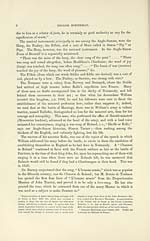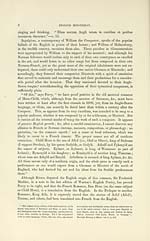Glen Collection of printed music > Printed text > Popular music of the olden time > Volume 1
(41) Page 7 - Chason Roland
Download files
Complete book:
Individual page:
Thumbnail gallery: Grid view | List view

NORMANS. — BATTLE OP HASTINGS.
Robert Wace, in the Roman de Rou, says that Taillefer sang with a loud voice
(chanta a haute voix) tlie songs of Charlemagne, Roland, &c., and M. de
Toulmon considers the song of Roland to have been a Chanson de Geste, or
metrical romance ; and that Taillefer merely declaimed parts of such poems, hold-
ing up those heroes as models to the assembled soldiers. The Chanson de Roland,
that was printed in Paris in 1837-8 (edited by M. Michel) from a copy in the
Bodleian Library, is a metrical romance in praise of the French hero, the Orlando
Innamorato, and Furioso of Boiardo, Berni, and Ariosto, but apparently of no such
antiquity,'' and it seems improbable that he should have been the subject of the
Norman minstrel's song. All metrical romances, however, were originally recited
or chanted with an accompaniment ; and Dr. Crotch has printed a tune in the
third edition of his Specimens of Various Styles of Music, vol. 1. p. 133, as the
" Chanson Roland sung by the Normans as they advanced to the battle of
Hastings, 1066," which I give as a curiosity, but without vouching for its
authenticity.
CHANSON ROLAND.
^^^
^
^
1 n f • C
1^^
"'cr
^EE
^
^
^
32
3=
-2=?"
t
i
3
i
rt-j
1-^-
TPf
"sr-
^-^^
^
^^
id
^
^^^^
^
-»
^-t^
"^=5"
^
^
5
Dr. Crotcli does not name the source from which he obtained this air, nor
have I been successful in tracing it.^ The story of Taillefer may, however, be
altogether apochryphal, as it is not mentioned by any contemporanj historian.
The English, according to Fordun, spent the night preceding the battle in
" It contains, also, about 4,000 verses ; and it seems still
more improbable that so lengthy a composition should
have been generally and popularly known. It is more
likely to have originated in the favorwith which an earlier
song was received.
^ The Chanson de Roland that has been printed re-
cently, edited by Sir Henry Bishop, is a Composition by
the Marquis de Paulmy, taken from Barney's History of
Music, vol ii. p. 276, but Dr. Burney does not give it as
an ancient song or tune. The tune, indeed, is not even
in imitation of antiquity.
Robert Wace, in the Roman de Rou, says that Taillefer sang with a loud voice
(chanta a haute voix) tlie songs of Charlemagne, Roland, &c., and M. de
Toulmon considers the song of Roland to have been a Chanson de Geste, or
metrical romance ; and that Taillefer merely declaimed parts of such poems, hold-
ing up those heroes as models to the assembled soldiers. The Chanson de Roland,
that was printed in Paris in 1837-8 (edited by M. Michel) from a copy in the
Bodleian Library, is a metrical romance in praise of the French hero, the Orlando
Innamorato, and Furioso of Boiardo, Berni, and Ariosto, but apparently of no such
antiquity,'' and it seems improbable that he should have been the subject of the
Norman minstrel's song. All metrical romances, however, were originally recited
or chanted with an accompaniment ; and Dr. Crotch has printed a tune in the
third edition of his Specimens of Various Styles of Music, vol. 1. p. 133, as the
" Chanson Roland sung by the Normans as they advanced to the battle of
Hastings, 1066," which I give as a curiosity, but without vouching for its
authenticity.
CHANSON ROLAND.
^^^
^
^
1 n f • C
1^^
"'cr
^EE
^
^
^
32
3=
-2=?"
t
i
3
i
rt-j
1-^-
TPf
"sr-
^-^^
^
^^
id
^
^^^^
^
-»
^-t^
"^=5"
^
^
5
Dr. Crotcli does not name the source from which he obtained this air, nor
have I been successful in tracing it.^ The story of Taillefer may, however, be
altogether apochryphal, as it is not mentioned by any contemporanj historian.
The English, according to Fordun, spent the night preceding the battle in
" It contains, also, about 4,000 verses ; and it seems still
more improbable that so lengthy a composition should
have been generally and popularly known. It is more
likely to have originated in the favorwith which an earlier
song was received.
^ The Chanson de Roland that has been printed re-
cently, edited by Sir Henry Bishop, is a Composition by
the Marquis de Paulmy, taken from Barney's History of
Music, vol ii. p. 276, but Dr. Burney does not give it as
an ancient song or tune. The tune, indeed, is not even
in imitation of antiquity.
Set display mode to: Large image | Transcription
Images and transcriptions on this page, including medium image downloads, may be used under the Creative Commons Attribution 4.0 International Licence unless otherwise stated. ![]()
| Special collections of printed music > Glen Collection of printed music > Printed text > Popular music of the olden time > Volume 1 > (41) Page 7 - Chason Roland |
|---|
| Permanent URL | https://digital.nls.uk/91367939 |
|---|
| Shelfmark | Glen.254 |
|---|---|
| Additional NLS resources: | |
| Attribution and copyright: |
|
| Description | Scottish songs and music of the 18th and early 19th centuries, including music for the Highland bagpipe. These are selected items from the collection of John Glen (1833 to 1904). Also includes a few manuscripts, some treatises, and other books on the subject. |
|---|
| Description | The Glen Collection and the Inglis Collection represent mainly 18th and 19th century Scottish music, including Scottish songs. The collections of Berlioz and Verdi collected by bibliographer Cecil Hopkinson contain contemporary and later editions of the works of the two composers Berlioz and Verdi. |
|---|

